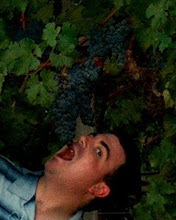Simply put, alcohol is derived from fermenting the sugar in the grapes with some yeast. If the winemaker chooses to ferment all the sugar out then the reasoning goes: the higher the sugar, the higher the alcohol percentage. You can get alcohol out of just about anything that has sugar in it. One of my other favorite adult drinks is whiskey. I like all types from all areas, but Irish is consistently my pick. The alcohol in these drinks is typically 40% or higher. Maybe that's why I'm not scared when a wine label states 15%, 16% or higher - not uncommon in todays wine world.
Alright, let's talk about California vs. France. There are some big differences between these two highly regarded wine regions, but the main one is France's growing areas are significantly more northerly than those in California. The further north, the less sunlight which leads to less photosynthesis which means it takes many more days for the same grapes, say Merlot, to come to full ripeness. Confused?
Let's try it another way: The latitude for Sonoma County is roughly 38 degrees N. For Bordeaux, France it's roughly 44 degrees N. Considerable difference? You betcha. Take a square foot of soil in Bordeaux and compare it to a square foot of soil in Sonoma and the one in Sonoma receives more sunlight every year just based on sun angle alone. More sun equals more heat which in turn means the grapes come to full ripeness sooner.
How does this relate to alcohol? When there's less heat, the sugar levels are generally lower which leads to lower alcohol levels. To the same respect, when there is more heat sugar levels are higher which means higher alcohol levels.
Why do we care? Because if a wine isn't balanced nothing else matters.
Balance occurs only when the vineyard manager(s) and winemaker(s) are working very well together. You see, there is much more to picking grapes than just sugar level. There is also acid, tannin and pH among other factors. All of these things need to be in "balance" in order for the resulting wine to be balanced. In some cases this can be a one to two day period in the vineyard.
When a wine is not balanced and has a very high alcohol level, you will know it right away. The sides of your tongue will burn from the moment the wine hits your mouth. Not a good sign at all. Sure, over time, that characteristic may fade, but the wine will never be balanced.
But if everything is done perfectly, the alcohol level could be quite high for instance 16.5% and you won't smell or taste it. That is balanced.
There is one down side to high alcohol that was recently talked about in an article by Dan Berger in the Press Democrat. In this article, Berger stated that higher alcohol levels meant that the wines couldn't age nearly as long as if they had lower levels. To the average wine consumer this doesn't really matter. Most wines are bought and consumed within a few hours. So the majority of people won't age that wine anyway.
The bottom line when drinking wine is that you enjoy it. So, should you care about the alcohol level? Sure. But is it the only thing to concern yourself with? Not a chance.
Cheers!


Great information. Question...How do the wine makers achieve the perfect balance?
ReplyDeleteGreat question. Perfect balance can only be achieved in the vineyard. When the levels of acid, sugar, tannin, pH and other factors meet at the perfect cross-section you can attain balance. All of these have different points of perfection. For instance when a grape is very young on the vine the acid level is very high and the sugar level is very low. As the grape matures, the acid level falls and the sugar level rises. At some point they intersect creating balance.
ReplyDeleteI hope that clears things up. I'm always happy to answer questions.